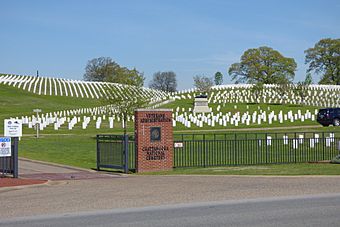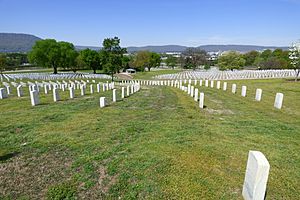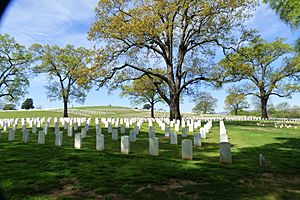Chattanooga National Cemetery facts for kids
Quick facts for kids |
|
|
Chattanooga National Cemetery
|
|
 |
|
| Location | 1200 Bailey Ave. Chattanooga, Tennessee |
|---|---|
| Built | December 25, 1863 |
| Website | Chattanooga National Cemetery |
| MPS | Civil War Era National Cemeteries MPS |
| NRHP reference No. | 96001013 |
| Added to NRHP | September 16, 1996 |

The Chattanooga National Cemetery is a special place in Chattanooga, Tennessee. It is a United States National Cemetery, which means it's a burial ground for military veterans and their families. This large cemetery covers over 120 acres. As of 2014, more than 50,000 people were buried there. It is managed by the United States Department of Veterans Affairs.
Contents
A Look at History
The cemetery was started in 1863. This happened during the American Civil War, right after the Battles of Chattanooga. Major General George Henry Thomas ordered it to be a burial place. It was for Union soldiers who died fighting.
How the Cemetery Grew
At first, about 75 acres of land were taken from local owners. Later, this land was bought. In 1867, it officially became the Chattanooga National Cemetery. By 1870, over 12,000 people had been buried there. Many of them were unknown soldiers.
Soldiers buried on nearby battlefields were also moved here. This included almost 1,500 burials from the Battle of Chickamauga. Franklin Guest Smith helped a lot to protect and grow the cemetery. A monument was built in his honor.
Burials from World Wars
During World War I and World War II, some German prisoners of war (POWs) died while held captive. They were buried in Chattanooga National Cemetery. After the wars, the German government paid to move other German POWs here. These POWs had been buried in Hot Springs National Cemetery.
A Historic Landmark
In 1996, the Chattanooga National Cemetery was added to the National Register of Historic Places. This means it is recognized as an important historical site.
Future of the Cemetery
The cemetery was once expected to stop new burials around 2015. But a recent expansion project has added space for over 5,000 more burials. Now, it is expected to be open for burials until 2045.
Important Monuments to See
The cemetery has several important monuments. These help us remember the people buried there and their stories.
- Memorial Archway: A tall archway, 40 feet high, built in 1868.
- Andrews Raiders Memorial: This monument was put up in 1890. It has a bronze copy of a train called The General. This train was stolen by a Union spy named James J. Andrews and his team. This event was part of the famous Great Locomotive Chase.
- German World War I Prisoner of War Monument: The German government built this monument in 1935. It honors the German POWs buried here.
Notable People Buried Here
Many brave and interesting people are buried at Chattanooga National Cemetery.
The Andrews Raiders
These were the men involved in the daring Great Locomotive Chase.
- Medal of Honor recipients:
- Private Samuel Robertson
- Sergeant Major Marion A. Ross
- Sergeant John M. Scott
- Private Samuel Slavens
- Other Raiders:
- James J. Andrews, the leader of the raid (he was a civilian)
- William H. Campbell, another civilian member
- Private Philip G. Shadrack
- Private George D. Wilson
Other Medal of Honor Heroes
The Medal of Honor is the highest award for bravery in the U.S. military.
- Master Sergeant Ray E. Duke: Honored for his actions in the Korean War. He also received Korea's version of the Medal of Honor.
- Corporal Desmond Doss: Recognized for his bravery in World War II. He was the first conscientious objector to receive the Medal of Honor.
- Private William F. Zion: A Marine who earned his medal during the Boxer Rebellion.
- Technical Sergeant Charles Coolidge: An Army soldier, he was the last person to get this award during World War II.
Other Famous Individuals
- Cal Ermer: A Major League Baseball player and a Marine Corps veteran.
- William P. Sanders: A Union Army officer during the Civil War.
- Timothy R. Stanley: A Brigadier General during the Civil War.
- Sammy Strang: A Major League Baseball player and coach at the United States Military Academy.
Other Noteworthy Burials
- 186 foreign prisoners of war from World War I and World War II.
- One Canadian soldier from World War I.





